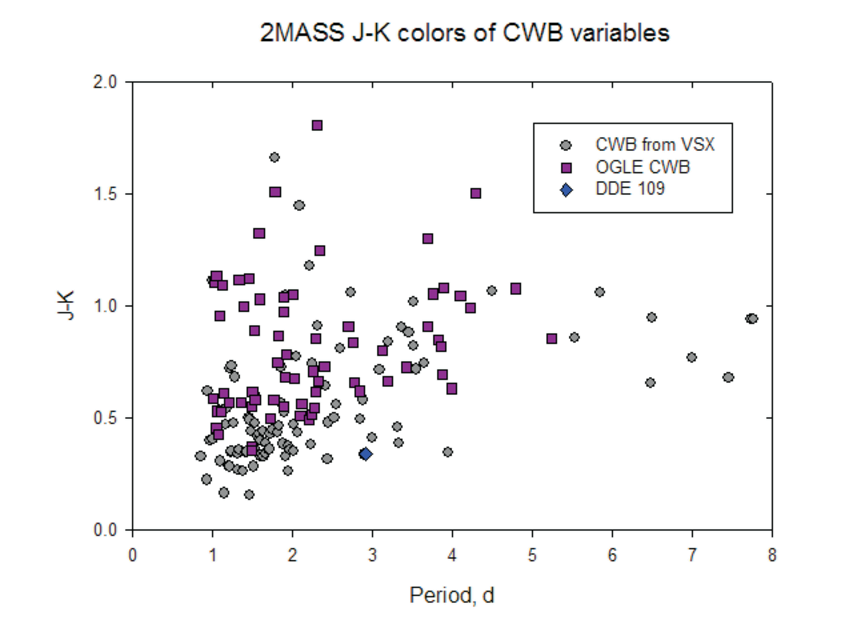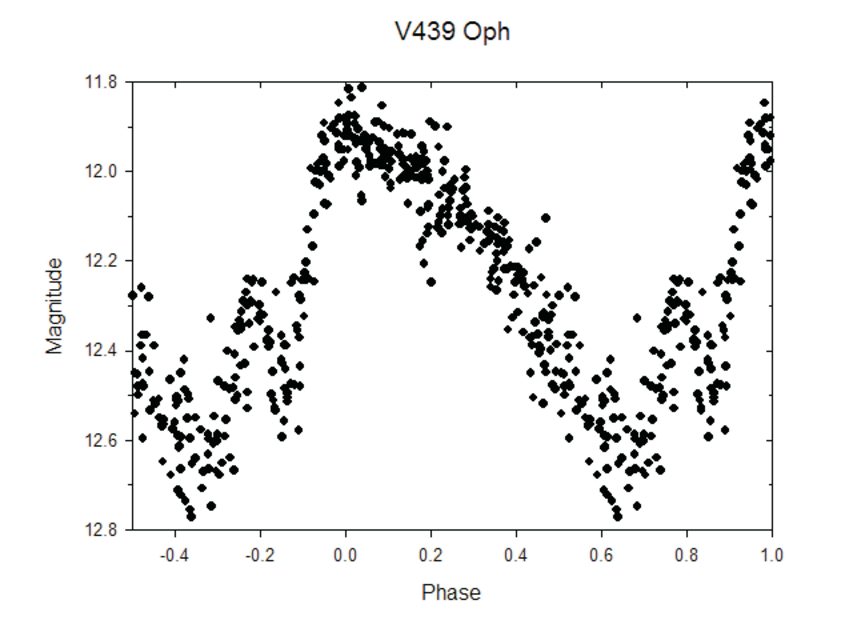|
Peremennye Zvezdy (Variable Stars) 37, No. 1, 2017 Received 17 May; accepted 6 June.
|
Article in PDF |
Unusual Short-period Cepheid with a Prominent Bump
D. V. Denisenko
Sternberg Astronomical Institute, Lomonosov Moscow State
University, Russia;
e-mail: d.v.denisenko@gmail.com
|
I report my discovery of a peculiar short-period
Type II Cepheid in Centaurus. The new variable is pulsating with
the period of 2 |
1. Discovery
The new variable in Centaurus, DDE 109 (GSC 07779-02075;
12![]() 46
46![]() 06
06![]() 50,
50,
![]() , J2000, UCAC4), was
found by the author during his routine search for variability in
online catalogues. The innovative method is based on identifying
variable stars from APASS data release (Henden et al. 2015) using
VizieR TAP service at http://tapvizier.u-strasbg.fr/adql/. The
method has proved to be effective, resulting in the discovery of
twenty new high-amplitude delta Scuti (HADS) stars, eight
cataclysmic variables, and two eclipsing subdwarfs listed at the
web site http://scan.sai.msu.ru/
, J2000, UCAC4), was
found by the author during his routine search for variability in
online catalogues. The innovative method is based on identifying
variable stars from APASS data release (Henden et al. 2015) using
VizieR TAP service at http://tapvizier.u-strasbg.fr/adql/. The
method has proved to be effective, resulting in the discovery of
twenty new high-amplitude delta Scuti (HADS) stars, eight
cataclysmic variables, and two eclipsing subdwarfs listed at the
web site http://scan.sai.msu.ru/![]() denis/VarDDE.html, as well
as of several hundred pulsating and eclipsing stars that will be
reported elsewhere. The variable discussed in this paper deserves
special attention because it stands out among others by its
unusual light curve.
denis/VarDDE.html, as well
as of several hundred pulsating and eclipsing stars that will be
reported elsewhere. The variable discussed in this paper deserves
special attention because it stands out among others by its
unusual light curve.
I suspected DDE 109 to be variable from its APASS magnitude errors
(
![]() ,
,
![]() ). Checking the Catalina
Real-Time Transient Survey data (Drake et al. 2009) at CRTS
website (http://nesssi.cacr.caltech.edu/DataRelease/) immediately
confirmed variability with an amplitude of about 0
). Checking the Catalina
Real-Time Transient Survey data (Drake et al. 2009) at CRTS
website (http://nesssi.cacr.caltech.edu/DataRelease/) immediately
confirmed variability with an amplitude of about 0![]() 8 in the
"white" light (magnitude range
8 in the
"white" light (magnitude range ![]() to 14.5). The object
named SSS_J124606.5-423805 was observed by the Siding Spring
Survey telescope on 67 nights from July, 2005 to May, 2013 with a
total of 263 data points.
to 14.5). The object
named SSS_J124606.5-423805 was observed by the Siding Spring
Survey telescope on 67 nights from July, 2005 to May, 2013 with a
total of 263 data points.
Figure 1 presents the red-light finding chart of the new variable DDE 109.
 |
Fig. 1.
The finding chart of DDE 109 from
the DSS red plate. The field of view is |
2. Period Determination
The times of observations were converted from JD to Barycentric
Julian Dates using the online period search service
http://scan.sai.msu.ru/lk/ by Kirill Sokolovsky. The best value of
the period, 2![]() 918086(80), was obtained using both the
Lafler-Kinman and Deeming methods. The phased light curve from
CRTS data is presented in Fig. 2. It is characterized by two peaks
of nearly the same height - the first one at 13
918086(80), was obtained using both the
Lafler-Kinman and Deeming methods. The phased light curve from
CRTS data is presented in Fig. 2. It is characterized by two peaks
of nearly the same height - the first one at 13![]() 78 and the
second one at 13
78 and the
second one at 13![]() 74. We consider the second (brighter) peak as
the maximum and the first (lower) peak as the "bump". Under this
assumption, the pre-maximum bump is at phase 0.82 and the local
minimum (13
74. We consider the second (brighter) peak as
the maximum and the first (lower) peak as the "bump". Under this
assumption, the pre-maximum bump is at phase 0.82 and the local
minimum (13![]() 85
85 ![]() ), at phase 0.90. One should also mention
the "shoulder" on the descending branch (phases 0.2-0.4).
), at phase 0.90. One should also mention
the "shoulder" on the descending branch (phases 0.2-0.4).
 |
Fig. 2.
The light curve of DDE 109 from CRTS
data folded with the best pulsation period
|
The light elements of DDE 109 obtained from CRTS data are:
3. Identifications in Catalogues
Being brighter than 15![]() , the new variable DDE 109 is present in
many astrometric and photometric catalogues. Several
identifications are listed below, with the corresponding
magnitudes.
, the new variable DDE 109 is present in
many astrometric and photometric catalogues. Several
identifications are listed below, with the corresponding
magnitudes.
GSC 07779-02075 (
![]() );
);
2MASS J12460650-4238059 (![]() ,
, ![]() ,
, ![]() );
);
GALEX J124606.5-423805 (FUV=N/A, NUV=19.28);
USNO-A2.0 0450-14689472 (![]() ,
, ![]() );
);
USNO-B1.0 0473-0357256(![]() ,
, ![]() ,
, ![]() ,
,
![]() );
);
UCAC4 237-060567 (![]() ).
).
The ![]() color index is
color index is ![]() . The galactic latitude
is +20
. The galactic latitude
is +20![]() , with the following extinction values from Schlafly and
Finkbeiner (2011):
, with the following extinction values from Schlafly and
Finkbeiner (2011): ![]() ,
, ![]() ,
, ![]() ,
,
![]() ,
, ![]() . Assuming the absolute magnitude of
DDE 109 to be
. Assuming the absolute magnitude of
DDE 109 to be ![]() , we obtain the estimate of 10 kpc for the
distance and
, we obtain the estimate of 10 kpc for the
distance and ![]() kpc for the height above the Galactic plane. The
object definitely belongs to the halo of Population II stars.
kpc for the height above the Galactic plane. The
object definitely belongs to the halo of Population II stars.
Figure 3 shows the period-color diagram of known CWB variables
from the AAVSO VSX database (Watson et al. 2006) that have both
![]() and
and ![]() magnitudes in the 2MASS catalogue. Uncertainties of
the
magnitudes in the 2MASS catalogue. Uncertainties of
the ![]() color indices are typically smaller than the symbol
size. 98 stars with GCVS names are plotted as gray circles;
69 stars from the OGLE bulge survey, as violet squares; and
DDE 109, as the blue diamond. The position of DDE 109 in the
diagram nearly coincides with that of the variable BC Aql
(
color indices are typically smaller than the symbol
size. 98 stars with GCVS names are plotted as gray circles;
69 stars from the OGLE bulge survey, as violet squares; and
DDE 109, as the blue diamond. The position of DDE 109 in the
diagram nearly coincides with that of the variable BC Aql
(
![]() ,
, ![]() ). However, the light curve of
BC Aql is typical of CWB stars.
). However, the light curve of
BC Aql is typical of CWB stars.
 |
Fig. 3.
The |
4. Discussion
To our knowledge, no other short-period Cepheid shows a
double-peaked light curve with nearly equal maxima. The most
remarkable pre-maximum bump is observed for the CWB-type variable
V439 Ophiuchi with the period
![]() , nearly 1.5 times
shorter than that of DDE 109. The phased light curve of V439 Oph
from ASAS-3 data (Pojmanski 2002) is shown in Fig. 4. Despite the
much lower first "bump" (0
, nearly 1.5 times
shorter than that of DDE 109. The phased light curve of V439 Oph
from ASAS-3 data (Pojmanski 2002) is shown in Fig. 4. Despite the
much lower first "bump" (0![]() 3 below the maximum) and the dip
(0
3 below the maximum) and the dip
(0![]() 2 above the minimum), the phases of both peaks, the dip, and
the "shoulder" in the case of V439 Oph are very close to those
for DDE 109.
2 above the minimum), the phases of both peaks, the dip, and
the "shoulder" in the case of V439 Oph are very close to those
for DDE 109.
5. Conclusion
The serendipitous discovery of DDE 109 shows that many remarkable variable stars remain not found despite their large-amplitude variability in publicly available databases and catalogues. The powerful tools of Virtual Observatory (namely, Table Access Protocol service at VizieR) can be effectively used for identifying such objects deserving a further study. Southern celestial hemisphere, including Siding Spring Survey data, should be thoroughly investigated. Multi-color photometry and spectroscopic observations of DDE 109 are strongly encouraged.
Acknowledgments: This research has made use of the VizieR catalogue access tool, CDS, Strasbourg, France. The original description of the VizieR service was published in Ochsenbein et al. (2000). The author thanks Prof. N. N. Samus and Dr. A. V. Khruslov for inspiring discussions.
References:
Drake, A. J., Djorgovski, S. G., Mahabal, A., et al., 2009, Astrophys. J., 696, 870
Henden, A. A., Templeton, M., Terrell, D., et al., 2015, American Astron. Soc. Meeting No. 225, id. 336.16
Ochsenbein, F., Bauer, P., Marcout, J., 2006, Astron. & Astrophys. Suppl., 143, 23
Pojmanski, G., 2002, Acta Astron., 52, 397
Schlafly, E. F., Finkbeiner, D. P., 2011, Astrophys. J., 737, 103
Watson, C. L., Henden, A. A., Price, A., 2006, Society for Astron. Sciences 25th Annual Symposium on Telescope Sciences, 47
